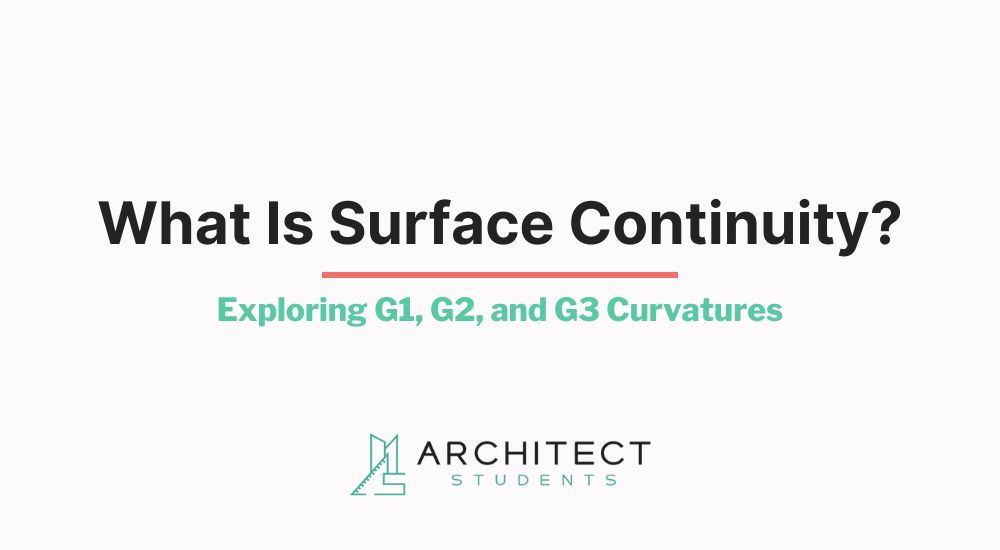In the realm of architectural design, the concept of surface continuity plays a pivotal role, particularly when dealing with complex, free-form structures. Originating from the fields of mathematics and engineering, surface continuity has found a significant place in modern architecture, allowing architects to create smooth, flowing forms that were once thought impossible. This article aims to demystify the concept of surface continuity, introducing its basic forms – G0, G1, G2, and G3 continuity – and exploring their practical applications in architectural design.

What is Surface Continuity?
Surface continuity refers to the smoothness of the transition where two surfaces meet.
It’s a fundamental concept in architectural design, particularly in creating complex shapes and forms. The degree of continuity determines how seamlessly these surfaces blend into each other, affecting both the aesthetic appeal and structural integrity of the design. Surface continuity is categorized into several levels, namely G0, G1, G2, and G3, each representing a higher degree of smoothness and complexity in the way surfaces connect. Understanding and applying these levels of surface continuity allows architects to create designs that are not only visually striking but also structurally sound.
G0 Continuity (Positional Continuity)
This is the most basic level of surface continuity. It ensures that two adjoining surfaces meet at a common point. G0 continuity does not concern itself with the direction in which the surfaces approach each other, only that they touch. This is crucial in architectural elements where surfaces intersect but do not necessarily need to flow into one another, such as the meeting point of a wall and a floor.
G1 Continuity (Tangent Continuity)
G1 continuity takes the concept a step further. Here, surfaces not only meet but do so in a way that their tangents (directions) at the meeting point are aligned. This means that the surfaces have a smooth, visually pleasing transition without any abrupt change in direction. This is especially important in architectural features like curved walls or stair railings, where a sudden change in direction would be visually jarring.
G2 Continuity (Curvature Continuity)
With G2 continuity, the curvature of the surfaces is also matched at the point of connection, ensuring a seamless transition. This level of continuity is critical in designs where the reflection or the light pattern on the surface needs to be consistent, such as in automotive design or in the façade of buildings with a reflective surface. In architecture, this is often seen in complex, free-form structures where a high level of aesthetic smoothness is desired.
G3 Continuity
This is an advanced level of surface continuity, where the rate of change of curvature is consistent at the junction of two surfaces. G3 continuity is about ensuring that the transition between surfaces is not only smooth but also harmonious in terms of how it feels and appears over its length. This type of continuity is often used in high-end, bespoke architectural projects where every detail of the surface transition is critical to the overall aesthetic and functional goal of the design.
Practical Applications in Architecture
The application of these concepts in architecture can be seen in various forms. From the sweeping curves of modern museums to the subtle contours of a sculptural façade, surface continuity plays a key role in the aesthetic and functional aspects of a building.
- Designing Free-form Structures: In contemporary architecture, free-form structures often rely on G2 and G3 continuities to achieve their seamless, flowing appearances. Buildings like the Guggenheim Museum Bilbao by Frank Gehry exemplify the use of these principles to create organic forms.
- Reflective and Glazed Surfaces: For buildings that feature reflective surfaces, such as glazed façades, achieving G2 continuity is essential to ensure that reflections are not distorted, maintaining the building’s visual integrity.
- Software in Design: Modern architectural design software like Rhino, CATIA, and Revit offers tools specifically geared towards achieving various levels of surface continuity. This allows architects to simulate and analyze the smoothness of transitions in their designs before construction.
- Structural Implications: Beyond aesthetics, surface continuity also has structural implications. Properly executed continuity can contribute to the structural strength and stability of curved elements in architecture.

